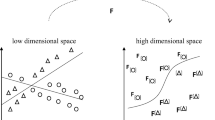Abstract
This study introduces a classifier founded on k-nearest neighbours in the complementary subspaces (NCS). The global space, spanned by all training samples, can be decomposed into the direct sum of two subspaces in terms of one class: the projection vectors of this class into one subspace are nonzero, and that into another subspace are zero. A query sample is projected into the two subspaces for each class, respectively. In each subspace, the distance from the projection vector to the mean of its k-nearest neighbours can be calculated, and the final classification rules are designed in terms of the two distances calculated in the two complementary subspaces, respectively. Allowing for the geometric meaning of Gram determinant and kernel trick, the classifier is naturally implemented in the kernel space. The experimental results on 1 synthetic, 13 IDA binary class, and five UCI multi-class data sets show that NCS compares favourably to the comparing classifiers, which is founded on the k-nearest neighbours or the nearest subspace, on almost all the data sets. The classifier can straightforwardly solve multi-classification problems, and the performance is promising.



Similar content being viewed by others
References
Cover TM, Hart PE (1967) Nearest neighbor pattern classification. IEEE Trans Inf Theory 13:21–27
Veenman CJ, Reinders MJ (2005) The nearest subclass classifier: a compromise between the nearest mean and nearest neighbor classifier. IEEE Trans Pattern Anal Mach Intell 27: 1417–1429
Cevikalp H, Larlus D, Douze M, Jurie F (2007) Local subspace classifiers: linear and nonlinear approaches. In: The 2007 IEEE Machine Learning for Signal Processing Workshop, Thessaloniki, Greece
García-Pedrajas N (2009) Constructing ensembles of classifiers by means of weighted instance selection. IEEE Trans Neural Netw 20: 258–277
Li B, Chen YW, Chen YQ (2008) The nearest neighbor algorithm of local probability centers. IEEE Trans Syst Man Cybern B 38: 141–154
Jiang L, Cai Z, Wang D, Jiang S (2007) Survey of improving k-nearest-neighbor for classification. In: Fourth international conference on fuzzy systems and knowledge discovery, 2007 (FSKD 2007) 1: 679–683
Fayed HA, Atiya AF (2009) A novel template reduction approach for the k-nearest neighbor method. IEEE Trans Neural Netw 20: 890–896
Balachander T, Kothari R (1999) Kernel based subspace pattern classification. In: Proceedings of the international joint conference on neural networks, vol 5, pp 3119–3122
Balachander T, Kothari R (1999) Introducing locality and softness in subspace classification. Pattern Anal Appl 2(1): 53–58
Balachander T, Kothari R (1999) Oriented soft localized subspace classification. In: Proceedings of the 1999 IEEE international conference on acoustics, speech, and signal processing, 1999, vol 2, pp 1017–1020
Nalbantov GI, Groenen PJF, Bioch JC (2007) Nearest convex hull classification. Tech. Rep. EI 2006-50, Econometric Institute
Weinberger KQ, Blitzer J, Saul LK (2006) Distance metric learning for large margin nearest neighbor classification. In: NIPS. MIT Press
Kumar MP, Torr P, Zisserman A (2007) An invariant large margin nearest neighbour classifier. In: IEEE 11th international conference on computer vision, 2007 (ICCV 2007), vol 2, pp 1–8
Vincent P, Bengio Y (2001) K-local hyperplane and convex distance nearest neighbor algorithms. In: NIPS
Cevikalp H, Triggs B, Polikar R (2008) Nearest hyperdisk methods for high-dimensional classification. In: Cohen WW, McCallum A, Roweis ST (eds) CICML ACM international conference proceeding series, vol 307, Helsinki, Finland. ACM, pp 120–127
Sam H (2008) K-nearest neighbor finding using maxnearestdist. IEEE Trans Pattern Anal Mach Intell 30: 243–252
Vapnik VN (1998) Statistical learning theory. Wiley-Interscience, New York
Liu Y, Ge SS, Li C, You Z (2011) k-NS: a classifier by the distance to the nearest subspace. IEEE Trans Neural Netw 22: 1017–1020
Liu Y, Cao X, Liu JG (2011) Classification using distances from samples to linear manifolds. Pattern Anal Appl. http://www.springerlink.com/content/k261001001288257/
Barth N (1999) The gramian and k-volume in n-space: some classical results in linear algebra. J Young Investig 2. Accessed 19 July 2011
Meyer CD (2001) Matrix analysis and applied linear algebra. SIAM, Philadelphia
Horn RA, Johnson CR (1986) Matrix analysis. Cambridge University Press, Cambridge
Laaksonen J (1997) Subspace classifiers in recognition of handwritten digits. PhD thesis, Helsinki University of Technology, Finland
Bertero M (1986) Regularization methods for linear inverse problems. In: Lecture notes in mathematics. Springer, Berlin, pp 52–112
Wieland A (1995) Twin spiral dataset. http://www.cs.cmu.edu/afs/cs/project/ai-repository/ai/areas/neural/bench/cmu/bench.tgz. Accessed 19 July 2011
Asuncion A, Newman D (2007) UCI machine learning repository. Accessed 19 July 2011
Keerthi SS, Lin C-J (2003) Asymptotic behaviors of support vector machines with gaussian kernel. Neural Comput 15: 1667–1689
Räetsch G, Onoda T, Müller K-R (2001) Soft margins for adaboost. Mach Learn 43: 287–320
Mangasarian OL, Wild EW (2006) Multisurface proximal support vector machine classification via generalized eigenvalues. IEEE Trans Pattern Anal Mach Intell 28: 69–74
Mu T, Nandi AK (2009) Multiclass classification based on extended support vector data description. IEEE Trans Syst Man Cybern B 39: 1206–1216
Schölkopf B, Smola AJ (2001) Learning with Kernels: support vector machines, regularization, optimization, and beyond. MIT Press, Cambridge
Liu Y, You Z, Cao L (2006) A novel and quick SVM-based multi-class classifier. Pattern Recognit 39: 2258–2264
Author information
Authors and Affiliations
Corresponding author
Appendices
Appendix 1
Proof of (7)
Based on [22], there exists
when A −1 exists. In addition to
we have
Substituting (34) into (6) yields (7).
Appendix 2
Proof of (13)
From (35), we have
i.e.
so α takes
and (13) is proved.
Rights and permissions
About this article
Cite this article
Yang, M., Liu, Y., Zhong, B. et al. Classification by nearness in complementary subspaces. Pattern Anal Applic 16, 609–622 (2013). https://doi.org/10.1007/s10044-012-0308-4
Received:
Accepted:
Published:
Issue Date:
DOI: https://doi.org/10.1007/s10044-012-0308-4




